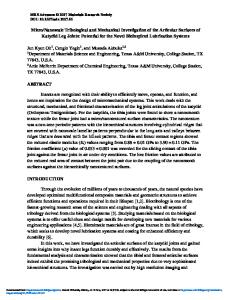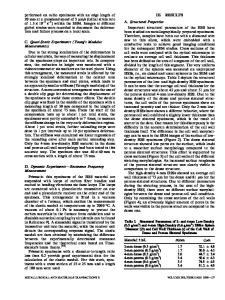Investigation of mechanical properties of tibia and femur articulations of insect joints with different joint functions
- PDF / 790,493 Bytes
- 4 Pages / 612 x 792 pts (letter) Page_size
- 88 Downloads / 399 Views
esearch Letter
Investigation of mechanical properties of tibia and femur articulations of insect joints with different joint functions Jun Kyun Oh , Department of Polymer Science and Engineering, Dankook University, 152 Jukjeon-ro, Suji-gu, Yongin-si, Gyeonggi-do 16890, Republic of Korea Spencer T. Behmer and Richelle Marquess, Departmentof Entomology, Texas A&M University, College Station, TX 77843, USA Ethan A. Scholar, Artie McFerrin Department of Chemical Engineering, Texas A&M University, College Station, TX 77843, USA Mustafa Akbulut, Department of Materials Science and Engineering and Artie McFerrin Department of Chemical Engineering, Texas A&M University, College Station, TX 77843, USA Address all correspondence to Jun Kyun Oh at [email protected] and Mustafa Akbulut at [email protected] (Received 31 March 2019; accepted 21 May 2019)
Abstract Insects have more than a million described species and represent more than half of all known living organisms. However, little is known about the operation and functions of the insect body, particularly their remarkable leg joints. This study is focused on partly filling this knowledge gap by using nanoindentation instruments to characterize the mechanical properties of leg joints from three different insects: a beetle, a mantis, and a dragonfly nymph. For all insect species, the tibia joint had the largest effective elastic moduli, followed by the femur joint, while the exocuticle had the smallest values.
Introduction The development of materials and coatings to enable prolonged operations of moving components in small-scale systems is becoming increasingly important, especially as the application of micro/nano-electromechanical systems (MEMS/NEMS) and micro/nano-robotic joint systems continues to increase.[1,2] Through millions of years of evolution, insects have evolved leg joints that operate efficiently and are durable—tolerating repeated rubbing and compression cycles during their lifetime.[3,4] Studying materials based on natural systems can provide important clues for developing effective materials with similar material properties for appropriate use, as well as practical applications.[5,6] A better understanding of insect joints can lead to new insights in the future design of bio-inspired coatings for nanoscale and microscale engineered systems.[7,8] The outer surfaces of insects, e.g., exocuticle[9,10] and wing surfaces,[11] have been extensively studied. In contrast, the mechanical properties of the inner surfaces of the exocuticle have not been investigated at the same depth. Over the lifetime of an insect, leg joints can withstand repeated bending, running, swimming, and jumping motions, and surpass the strength and durability of mechanical devices made by humans.[12,13] For example, the exertion forces of insect joints are ten to several hundred times greater than their body weight, as shown in locusts (eight times), fleas (135 times), and froghoppers (414 times). This vastly exceeds that of humans (three times).[14] Hence, it is essential to study th
Data Loading...










